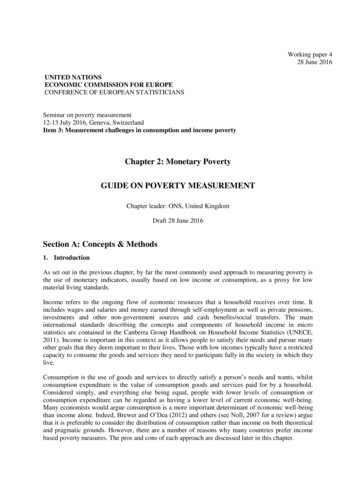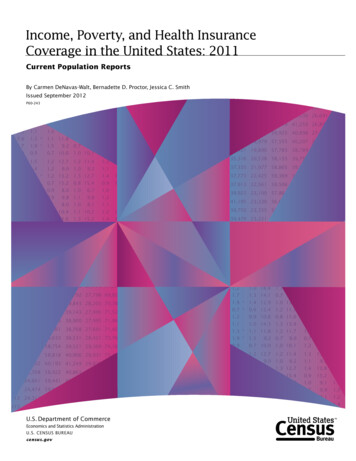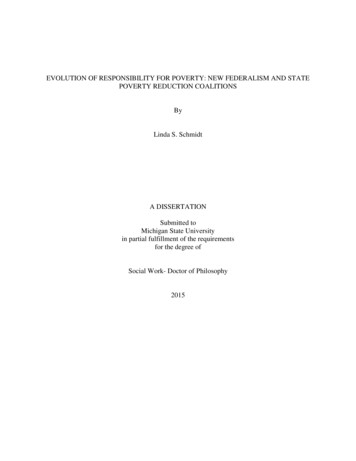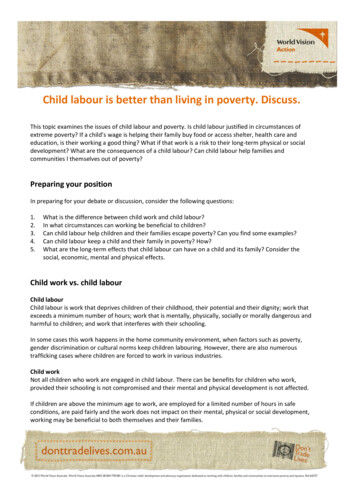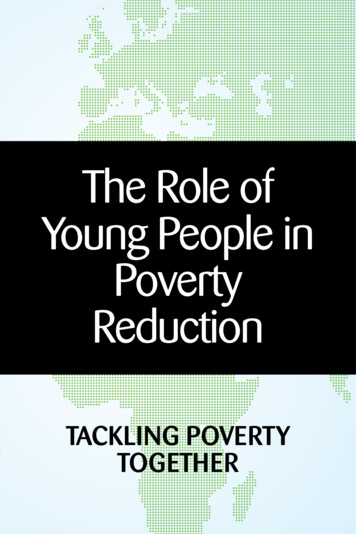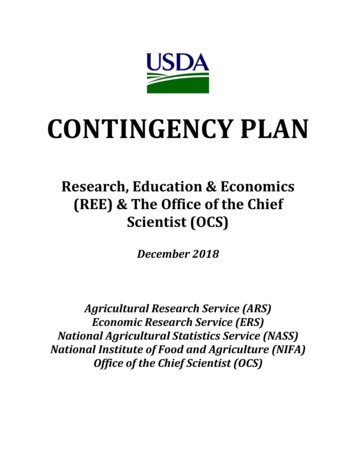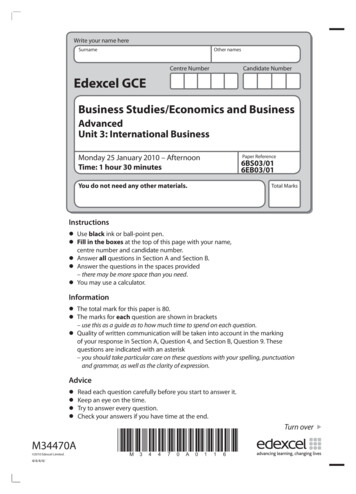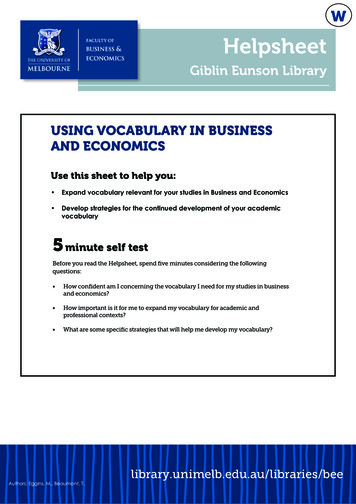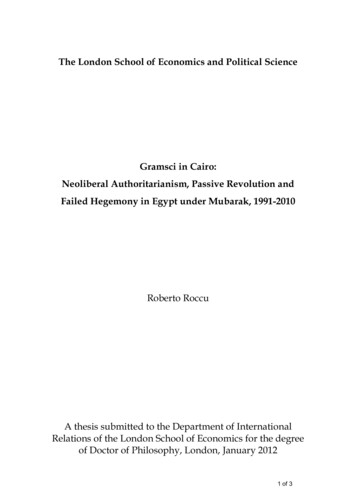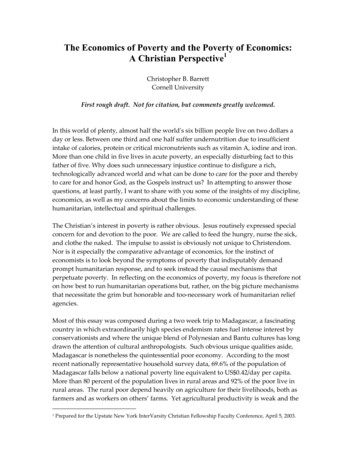
Transcription
The Economics of Poverty and the Poverty of Economics:A Christian Perspective1Christopher B. BarrettCornell UniversityFirst rough draft. Not for citation, but comments greatly welcomed.In this world of plenty, almost half the world's six billion people live on two dollars aday or less. Between one third and one half suffer undernutrition due to insufficientintake of calories, protein or critical micronutrients such as vitamin A, iodine and iron.More than one child in five lives in acute poverty, an especially disturbing fact to thisfather of five. Why does such unnecessary injustice continue to disfigure a rich,technologically advanced world and what can be done to care for the poor and therebyto care for and honor God, as the Gospels instruct us? In attempting to answer thosequestions, at least partly, I want to share with you some of the insights of my discipline,economics, as well as my concerns about the limits to economic understanding of thesehumanitarian, intellectual and spiritual challenges.The Christian’s interest in poverty is rather obvious. Jesus routinely expressed specialconcern for and devotion to the poor. We are called to feed the hungry, nurse the sick,and clothe the naked. The impulse to assist is obviously not unique to Christendom.Nor is it especially the comparative advantage of economics, for the instinct ofeconomists is to look beyond the symptoms of poverty that indisputably demandprompt humanitarian response, and to seek instead the causal mechanisms thatperpetuate poverty. In reflecting on the economics of poverty, my focus is therefore noton how best to run humanitarian operations but, rather, on the big picture mechanismsthat necessitate the grim but honorable and too-necessary work of humanitarian reliefagencies.Most of this essay was composed during a two week trip to Madagascar, a fascinatingcountry in which extraordinarily high species endemism rates fuel intense interest byconservationists and where the unique blend of Polynesian and Bantu cultures has longdrawn the attention of cultural anthropologists. Such obvious unique qualities aside,Madagascar is nonetheless the quintessential poor economy. According to the mostrecent nationally representative household survey data, 69.6% of the population ofMadagascar falls below a national poverty line equivalent to US 0.42/day per capita.More than 80 percent of the population lives in rural areas and 92% of the poor live inrural areas. The rural poor depend heavily on agriculture for their livelihoods, both asfarmers and as workers on others’ farms. Yet agricultural productivity is weak and the1Prepared for the Upstate New York InterVarsity Christian Fellowship Faculty Conference, April 5, 2003.
2soils, forests and hydrological systems on which smallholder farming fundamentallydepends are under significant threat from anthropogenic and natural causes. Because itso typifies poor economies, I will illustrate some of my core points with brief anecdotesfrom some of the many Malagasy who have been some of my most important teachersabout not only the economics of poverty, but also about the dignity and majesty ofhuman life and the whole of God’s Creation.The Economics of Poverty“Most of the people in the world are poor, so if we knewthe economics of being poor we would know much of theeconomics that really matters. Most of the world s poorpeople earn their living from agriculture, so if we knew theeconomics of agriculture we would know much of theeconomics of being poor.”- Theodore W. SchultzThese words from T.W. Schultz’s 1979 Nobel Prize in Economics lecture are no less truetoday than they were a quarter century ago. Most of my remarks will therefore centeraround poor rural folk, the small farmers and landless laborers who comprise the toooften-invisible majority of the world’s population, especially of the world’s poor. Wehave nonetheless advanced significantly in our understanding of poverty since Schultz’sseminal contributions. I therefore try in this essay to relate what I consider the mostimportant advances in economists’ understanding of the etiology of poverty.Given the Christian audience, however, I hazard a highly unorthodox structure to thefirst part of this discussion, organizing my reflections on contemporary understandingof the economics of poverty around five broad themes of particular salience toChristians: hope, agency, discipleship, grace and transformation. We economists do notcommonly employ such labels in our research. But perhaps this structure will helpthose who sometimes struggle to find the Christian content in seemingly secular work.HopePerhaps the most distressing characteristic one frequently encounters among the poor ishopelessness, a general resignation to ongoing physical deprivation and difficulty inenvisioning a materially improved existence. Were these conditions chosen out ofascetic discipline, it would be unspeakably admirable. But for most of the world’s poor,deprivation is less a discipline than a passion. Hence the Christian obligation to showcompassion for the poor, literally to share their passion as we do that of our Lord on theCross.
3Economists have been steadily developing and improving formal theoretical models andempirical tools and evidence so as to improve our understanding of the nature andcausality of poverty, especially the lack of hope one observes too frequently in poorcommunities. Of particular note, increased availability of longitudinal data at householdand individual level is changing empirical poverty research in ways that are profoundlyaffecting our understanding of poverty. For years now, the staple metric has been theFoster-Greer-Thorbecke (1984, hereafter FGT) family of decomposable povertymeasures. The FGT poverty metric encompasses the headcount measure (the proportionof people in a population falling below the poverty line), the poverty gap measure (theamount of annual income or expenditure required to move all poor people above thepoverty line if funds transfers could be perfectly targeted for the poor) and moredistributionally-sensitive measures of poverty within a population. FGT measures offera powerful, but merely cross-sectional view of poverty. With advances in dataavailability and methods, economists are increasingly moving from such “snapshot”views of poverty to “video” perspectives, tracking the path followed by the poor overtime. This enables a variety of important refinements.One important recent advance comes from a growing appreciation that much poverty istransitory in nature (Baulch and Hoddinott 2000). People commonly suffer short-termincome losses or reductions in expenditures that may push them below the poverty linefor a relatively brief period of time. Then they recover, often without any assistancefrom charities or governments. While even transitory poverty is plainly undesirable, theobvious capacity of the transitorily poor to pull themselves up by their bootstrapstypically causes policymakers and scholars to worry less about those who are onlytemporarily poor than about those who remain poor for very long periods of time. Thetransitorily poor have the hope and well-founded expectation of exiting povertyrelatively quickly.Attention is therefore rightly focusing more than ever on “chronic” or “persistent”poverty, and the associated poverty traps that give rise to persistent poverty. In mostwealthy countries, poverty is generally a short-lived phenomenon; most poverty is notchronic. In the United States, for example, the median time in poverty is only 4.5 months(Naifeh 1998). Less than one quarter of those living below the poverty line remainbelow the poverty line 12 months later. Although our current cross-sectional povertyrate of 11.7 percent is relatively high, the long-term, structurally poor are a very smallminority, roughly one percent of the United States population.
4Consider now the difference between those statistics on poverty in the United States andthe poverty dynamics of peoples living in the drylands of northern Kenya and in thecentral and southern highlands of Madagascar. My collaborators and I have beenworking in these sites for several years and have recently assembled directly comparablelongitudinal observations on random samples of households (in econometric parlance,“panel data”). The leftmost point on each plot in Figure 1 reflects the headcount povertymeasure (i.e., the proportion of the population below the poverty line) at one point intime.2 The subsequent points depict the percentage of the population that was poor inthe initial period and that remained poor in the subsequent period. The curvesnecessarily slope down because a portion of poverty is transitory, as previouslydiscussed.Figure 1: Comparative Poverty Dynamics70Ngambo, Northern Kenya 2000-2( 0.25)Percent of population605040Fianarantsoa, Southern Madagascar1997-2002 ( 0.25)Vakinankaratra, Central Madagascar1997-2002 ( 0.25)302010United States 1993-94 ( 15.05)0012345Continuous years in povertySources: USA: Naifeh (1998), others BASIS CRSP project. Poverty line levels areall in inflation-adjusted 2002 US dollars.What is most striking to me in comparing these graphics is that although the UnitedStates suffers a high headcount rate of poverty for a wealthy country – albeit, measuredagainst a relatively generous poverty line equivalent to 15.05 per person per day – mostpoverty in the United States is plainly transitory and the population share of thepersistently poor is small. This is reflected in the steep slope of the persistent povertydynamics curve plotted in Figure 1 for the United States. In the United States, theprobability that a person who is poor today will still be poor in 24 months is less than 13percent. By contrast, in northern Kenya, the equivalent probability – and against apoverty line of only US 0.25/day per capita! – is 92 percent. In the southern Madagascarhighlands, the probability of remaining poor for five years is nearly 82 percent.The take-home point here is that it is not just the magnitude of poverty but, perhaps evenmore importantly, the nature and duration of poverty that differs in much of thedeveloping world from that in the United States and other wealthy countries. Whereanti-poverty policy in the wealthy countries largely revolves around the provision ofsafety nets to cushion people against short-term shocks and to help them “get back on2The relevant poverty line appears in parentheses, expressed in 2002 US dollars per day per person.
5their feet again” quickly, in the developing countries the task is necessarily far morecomplex. This is of concern not merely because of the severe material deprivation itrepresents, but equally because of the hopelessness such dim prospects can induce, withsevere cultural, moral, political and spiritual implications.The emerging dynamic or “video” view of the economics of poverty and the growingappreciation of the hopelessness induced by chronic poverty give particular salience tothe concept of poverty traps into which people may fall and have some difficultyescaping. Scholars are slowly coming to appreciate that chronic poverty associated withapparent poverty traps may be widespread, especially in rural areas of the developingworld, and that the causality of and appropriate policy responses to chronic povertymay differ from those for transitory poverty. But the causality behind the poverty trapphenomenon remains murky.AgencyThe essence of the poverty trap is that one chooses to stay in a situation that almost surelyimplies a life of poverty. It is not that people are entirely powerless over theircircumstances. God’s children are blessed with the freedom to choose what we eat,where we live, how we spend our time, and so forth. But in some places and for somepeoples, the choice set is relatively limited and none of the feasible options is especiallyattractive. Where chronic poverty is widespread, there is, on average, insufficientincentive to escape the poverty trap to induce the real sacrifice (of meager currentconsumption) needed to grow out of poverty. In particular, beneath the idea of povertytraps lies the necessary existence of critical thresholds that people have a difficult timeclimbing over and below which people can fall unexpectedly.3Absent such thresholds, all poverty would be transitory with everyone accumulatingproductive assets until they converged on a single equilibrium income level, as positedby neoclassical economic growth theory (Solow 1956). Overwhelming empiricalevidence against such unconditional convergence has motivated a flurry of researchover the past twenty years on “new” or “nonergodic” theories of economic growth(Romer 1986, Lucas 1988, Azariadis and Drazen 1990) and the microfoundations ofpoverty traps (Loury 1981, Banerjee and Newman 1993).4This nonetheless remains a severely underexplored area of economic research. Weknow that financial market failures are especially important to the perpetuation ofpoverty. Such failures arise due to institutional problems associated with poormanagement and limited legal contract enforcement, to misguided government financialpolicies, and to the extraordinarily high cost of doing business in places with poorThe fall is necessarily unexpected – we will refer to them as “shocks” – for if one could anticipate a shocksevere enough to push one past such a threshold, one would avert it if at all possible.4 Easterly (2001) offers an especially accessible, even entertaining, treatment of the evolution of growththeory and the empirical evidence on economic growth.3
6communications and transport infrastructure. Because financial products – credit,insurance and savings – permit people to decouple current expenditures from currentincome, they permit strategic investment (and prevent distress sales of productiveassets) without forcing draconian sacrifices in terms of present consumption. Thosewithout access to simple financial products are commonly trapped in chronic poverty.Consider the case of a farmer in the little village of Iandratsay, in Madagascar’s centralhighlands, who recently explained to me how he sells rice at harvest in order to pay hischildren’s school fees and his hired harvest workers, but he then must buy back an evengreater volume of rice six months later at a price effectively 85 percent higher (once onemakes proper adjustments for different units of account, paddy-rice conversion andstorage losses). Like many other small farmers, this gentleman is using the rice marketas a quasi-credit market, at an implicit compound annual interest rate greater than 300%,because he cannot get interseasonal loans any place else. Yet he also laments hisinability to muster the 60 he would need to upgrade from the local Zebu breed cow hehas now to a higher-yielding European cross-bred cow producing more than twice asmuch milk. At current milk market prices, the extra milk would increase his income by 60 in just over one month. The lack of access to even a two month loan of 60 at aninterest rate of 50% precludes this fellow from making a strategic investment that couldsignificantly improve his and his family’s situation.Similarly, most poor rice farmers in Madagascar are not taking up a remarkable new ricecultivation method known as SRI, for the system of rice intensification, which wasdeveloped locally by a French missionary priest in Madagascar and which requires nopurchased inputs such as improved seed or inorganic fertilizer. SRI has been repeatedlyshown to double and triple rice yields in Malagasy farmers’ fields and thus, at firstblush, seems an excellent technology for helping boost the well-being of poor farmersand agricultural workers. Yet few poor farmers are trying it (Moser and Barrett 2003).There seem to be two big reasons. The first is, again, finance. The poorest farmers’hungry season begins as they exhaust their rice harvest from the previous season andbegin preparing their rice fields for the next season. During this period, they have tofind wage employment to earn cash with which to buy food for their families. Althoughlabor productivity (output per day worked) increases significantly, on average, underSRI, this method requires some added labor investment early in the season and thereduced current cash income cannot compensate for higher future harvest when thefarmer cannot borrow over the intervening season to feed his family. The second reasonis that poorer farmers tend to have less land with poorer water control. SRI requiresmore careful water management than does traditional rice cultivation. A small farmerhas to coordinate with many neighbors to get them all to switch to SRI if they are to getthe water management right. That rarely happens. Such coordination failures amongpoor households are another prime reason for nonadoption of an exceedingly promisingtechnology by the poor.
7The point of the preceding anecdotes is that any solid understanding of the etiology ofchronic poverty must confront the central role of human agency. People rationallychoose strategies that leave them poor because superior options are either infeasible orunattractive to them, given the incentives they face. If one wants to help the poor, it isnot enough to create wonderful new technologies. One must make them accessible andattractive enough that the poor will freely choose to change their behaviors in a way thatcan predictably grow their incomes over time, enable them to climb out of the povertytrap in which they find themselves ensnared.Figure 2: Income Orderings byLivelihood Strategy in RwandaCumulative frequency1.00.80.60.40.20.00100200300400Total HH Income (1000 FRW)FFWFTFMixed500MSOMoreover, not everyone’s choice set is the same. Figure 2 (adapted from Barrett et al.2000) depicts the cumulative frequency distributions of total income among 1079households in Rwanda, organized into four distinct livelihood strategies. The farm andfarm worker (FFW) strategy includes households that only work as unskilledagricultural laborers or farm their own land. The full-time farmer (FTF) strategyrepresents households that farmed their own land and livestock and had no off-farmemployment. The mixed strategy includes non-farm employment with farming andunskilled agricultural labor. Finally, the mixed-skilled only (MSO) strategy involvesonly farming or skilled non-farm labor for a salary or as an entrepreneur. In Rwanda,full time farming (FTF) and especially farm and farm worker (FFW) livelihoodstrategies, are plainly stochastically dominated by mixed strategies, especially thoseinvolving only skilled labor and farming (MSO). One would never choose to draw anincome randomly from the farm and farm worker cohort’s distribution if one couldinstead draw from the mixed skilled-only group’s distribution. These welfare orderingsof livelihood strategies appear strongly related to barriers to entry that impede access tomore remunerative livelihoods by those lacking the necessary financial, human ornatural capital to undertake these activities (Dercon and Krishnan 1996, Barrett, Reardonand Webb 2001). Full-time farming is only an option for those endowed with enoughland or livestock to absorb all the adult labor in the household. Skilled non-farmemployment is only available to those with education, particular skills (e.g., blacksmiths,
8lorry drivers), or the necessary financial capital to start a business. Initial conditionsmatter.DiscipleshipThis leads directly to the importance of discipleship. A disciple eschews comfort andcomplacency in favor of constant seeking for new insights and challenges, albeit about asingle, core Truth. The challenge of Christian discipleship is to go beyond merelyasserting or displaying our faith to regularly venturing beyond our comfort zone inorder that we might better discern and follow God’s will.The challenge of escaping poverty is strikingly similar. The poor must be willing andable to learn new skills and technologies, to acquire education, and to uncover andexploit new market opportunities in order to increase the productivity of the productiveassets they hold and thereby increase incomes and other measures of well-being. Thevast majority of the poor’s productive assets are embodied in their labor power and, to alesser degree, in the agricultural land they control. Hence the importance of public andprivate investment in improving agricultural technologies, as well as in education, at alllevels, primary through tertiary. Education and technological improvement are themost direct and effective means of increasing rural labor and land productivity.Perhaps the most basic lesson of Solow’s (1956) Nobel Prize winning research is thateconomic growth requires technological change. Due to diminishing returns, mereaccumulation of capital, land, labor or other productive assets cannot provide sustainedincreases in productivity, income or well-being. At the macro scale, almost all economicgrowth and poverty reduction is driven ultimately by technological change. Moreover,the constraints seem to exist largely at the macro level as well; I have yet to meet a poorfarmer who did not want both to educate his or her children as long and as well aspossible and to find new and improved ways of sustainably increasing his or her farmoutput and the earnings to be made per unit of output. The poor are prepared topractice economic discipleship but are too rarely presented the opportunity.Economists and international donors would do well to keep the fundamental lesson oftechnological change firmly in mind. The research of another Nobel Laureate, BobFogel, emphasizes that technological change has been causally related to all significantimprovements in human nutrition, physical stature and life expectancy in recordedhuman history. More recently, the 1960s and 1970s’ massive investment in improvingseed, fertilizer, irrigation and basic agricultural machinery, as well as in education atprimary through tertiary levels led to rates of increase in literacy and life expectancy anddecreases in malnutrition and poverty that were unprecedented in human history. Sospectacular and important was the progress in cereal grain production that the NobelPeace Prize for 1970 was awarded to a plant breeder, Dr. Norman Borlaug!
9Figure 3: US Foreign Assistance FlowsAs % 197519801985199019959000Millions of Real, 1998 US0.8%6000Rates of growth in crop yields and in literacy and reduction of hunger and povertybegan stalling out in the 1970s and then collapsed in the 1990s for a complex set ofreasons related to global politics and recession, social and political unrest in much of thedeveloping world, and a sharp shift in international aid modalities. Donors andgovernments began turning away from international assistance, especially the provisionof global and national public goods through agricultural technology development andinvestment in rural feeder roads, schools, electrification, extension services, agriculturalresearch institutions, and public security. This is evident in Figure 3 (from Barrett andCarter 2002), which shows foreign assistance flows from the United States, both in real(i.e., inflation-adjusted) dollars and as a share of national gross domestic product. Notcoincidentally, a striking slowdown in poverty reduction began soon thereafter. Justlike the poor themselves, individuals and institutions committed to helping reducechronic poverty around the world need to practice discipleship, constantly seeking newinsights and challenges so as to better discern and practice the single, core truth thattechnological advance is the only sustainable path out of poverty. Moreover, we need toheed Paul’s instructions to the Corinthians as we consider how best to use our riches in apoor world:“For you know the generous act of our Lord Jesus Christ,that though he was rich, yet for your sakes he becamepoor, so that by his poverty you might become rich. I donot mean that there should be relief for others andpressure on you, but it is a question of a fair balancebetween your present abundance and their need, so thattheir abundance may be for your need, in order that theremay be a fair balance. As it is written, “The one who hadmuch did not have too much, and the one who had littledid not have too little.” (2 Corinthians 8:9,13-15).GraceBecause income is merely the product of the asset stock one controls and the rate ofreturn on those assets, chronic poverty necessarily arises from meager asset
10endowments, low rates of return, or both. Human agency plays an important role inestablishing one’s asset holdings and productivity, as already discussed, through theresource allocation choices people make, particularly their choices regarding investmentin asset accumulation and in acquiring and learning new technologies.Nevertheless, much progress is fortuitous, albeit predictable. One of my father’s favoritephrases during my childhood was “you make your own breaks.” There’s great wisdomin that remark. There are consequences to our actions; our choices change theprobability distributions we face over outcomes. But our choices are in no sensedeterministic of those outcomes. Grace – the unmerited favor of God – is ever present,although remarkably underappreciated. For example, I am not a tenured professor at anIvy League University because I am smarter or hard working than those who are not,but because I have been materially luckier than the many others who are at least assmart or hard working as I am. One reason that I so value spending time with poorhouseholds in my field research sites is that they force me to accept this fundamentaltruth. I marvel at the creative solutions they come up with to tricky problems, at theirfortitude and industriousness, and, not least, at the injustice of their and their children’shopelessness and physical sufferings. My beautiful, healthy family and successful careerare evidence of grace, of the unmerited love and favor God has showered on me.God’s grace may be no less present in the lives of the poor, but it is manifest in starklydifferent ways. Their suffering is, as Jesus tells us on curing the man who was blindfrom birth (John 9), an opportunity for us to witness God’s power and to respond toGod’s call to love. For the things we possess are not really ours, but God’s and we arecalled to acknowledge this through almsgiving and acts of compassion and selflessness.Luke 12 provides especially clear direction in this regard, instructing us to “seek hiskingdom, and these things shall be yours as well”, (12:31) and cautioning that“every one to whom much is given, of him will much be required; and of him to whommen commit much they will demand the more” (Luke 12:48).Grace explains a great deal of chronic poverty. Most of the poor have simply not been asmaterially lucky as the non-poor have been. In the presence of crucial thresholds thatcreate poverty traps, luck can have persistent effects, for good or for ill. Perhaps thesimplest way to see this is to study the effect of one’s genetic and material inheritance onone’s subsequent earnings. Recent research on the United States5 suggests that about 65percent of fathers’ earnings differentials relative to the broader population is transmittedto their children (Mazumder 2001), with that transmission rate growing over the pastcouple of decades (Levine and Mazumder 2002). Relatedly, a child born in the bottom 10percent of the family income distribution in the United States has a 51 percent chance ofending up in the bottom 20 percent as an adult (Hertz as quoted by Krueger 2002).Economic status persists intergenerationally, even in the United States where, as weUnfortunately, there have been no good economic studies of intergenerational earnings or wealthtransmission in developing countries.5
11have seen, there is relatively great economic mobility and most poverty is thereforetransitory.The role of chance in chronic poverty is perhaps best understood by the poor, who mostcommonly define their poverty in terms of insecurity, rather than low income levels(Narayan et al. 2000).6 While it is often recognized that poverty breeds insecurity, thereverse is also true because insecurity distorts asset accumulation strategies. Forexample, in Africa, farmers cut the forests and deplete soil nutrients in response to priceand yield risk. Food traders limit employment of able-bodied workers and sleep withtheir inventories for fear of theft. Families reduce food intake to cope with shocks,thereby diminishing children’s educational attainment. Even in a good year inMadagascar, like 2000/1, only 21% of cultivated plots did not suffer productionproblems associated with water (too much, too little, too early or too late), pests, hail,plant disease, or wind damage due to cyclones. Once one controls for such risk, medianfarmers are technically efficient, although the output losses associated withenvironmental shocks commonly exceed one-third of potential output (Sherlund et al.2002). But in the face of such risk, farmers rationally trade off yield for shock-resistancein cultivars, limiting their capacity to accumulate marketable surpluses.The common denominator to these examples is that poor people respond to insecuritytoday in ways that compromise their capacity to build a better life for themselvestomorrow. Such behavior is rational. It reflects the constraints that affect the poor’scapacity to pursue strategies needed to break out of the poverty traps that have capturedthem and the associated relief traps that have stymied contemporary developmentpolicy (Barrett and Carter 2001).Stocks of financial, natural, manmade, and human capital help individuals manage riskso as to prevent vulnerability. Vulnerability goes hand in hand with asset poverty. Yetasset ownership is only a necessary condition against vulnerability. The poor can’t eatcurrency or soil or the
Apr 05, 2003 · the economics of being poor we would know much of the economics that really matters. Most of the world s poor people earn their living from agriculture, so if we knew the economics of agriculture we would know much of the economics of being poor.” - Theodore W. Schultz These words from
